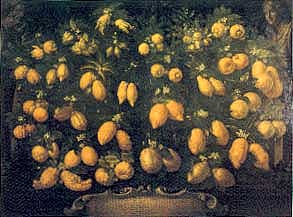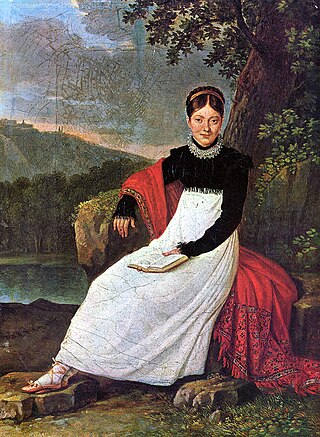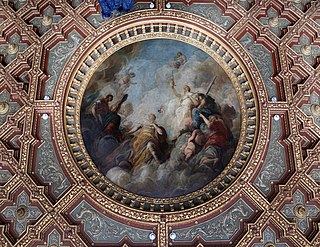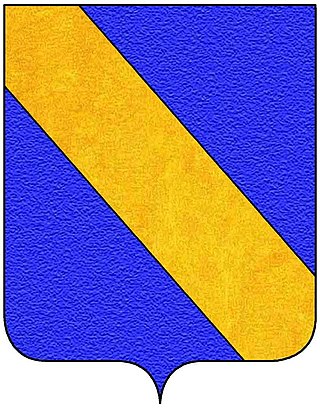

Gregorio Guglielmi (13 December 1714, Rome - 2 February 1773, Saint Petersburg) was an Italian-born fresco painter who worked primarily in Germany.


Gregorio Guglielmi (13 December 1714, Rome - 2 February 1773, Saint Petersburg) was an Italian-born fresco painter who worked primarily in Germany.
His artistic education concluded with lessons from Francesco Trevisani, but he was already turning toward the Academic style of Sebastiano Conca, with whom he may also have studied. [1] There are some indications that he studied in Paris during the 1740s and became acquainted with Claude Joseph Vernet. Early on, he obtained the patronage of Cardinal Alessandro Albani and may have also been supported by Cardinal Neri Maria Corsini.
In 1752, he was invited to Naples by the architect, Ferdinando Fuga, but court intrigues prevented him from obtaining any major commissions. However, Queen Maria Amalia introduced him to her father, Elector Frederick Augustus II, who arranged for him to work in Dresden. [2]
His Academic inclinations were enhanced in Germany; where he met Pietro Metastasio. In 1755, he created frescoes, inspired by Metastasio, at what is now the Austrian Academy of Sciences, and in Schönbrunn Palace, upon commission by the Sardinian ambassador, Luigi Gerolamo Malabaila (1704-1773). The latter were heavily damaged in World War II. In 1764, at the invitation of a painter named Sophonia De Derichs (1712-1773), he was working in Berlin. A major project, proposed by King Stanisław August Poniatowski for Ujazdów Castle never came to fruition. [2]
The following year, he made a temporary return to Italy to paint an altarpiece at the Chiesa dei Santi Martiri and murals at the Royal Palace in Turin, followed by frescoes at the Cappella Colleoni in Bergamo. He then went back to Germany, creating frescoes for the main hallway at the Schaezlerpalais in Augsburg.
As early as 1767, he had submitted drawings to the Russian court in Saint Petersburg. In 1770, he was finally called there by Catherine the Great, assisted by the De Derichs, who had already established themselves at the court. But, except for some portraits, his work there never progressed beyond the initial sketches. [1] In fact, it was said (by the sculptor, Étienne Maurice Falconet), that he died of a "putrid fever" after Catherine severely criticized a portrait of her. For some commentators, the fact that he and De Derichs died on the same day, followed by De Derichs' wife the day after, suggests that they were poisoned. No motive has been proposed, although Falconet's comment may indicate that he was not well-liked. [2]

Girolamo Rainaldi was an Italian architect who worked mainly in a conservative Mannerist style, often with collaborating architects. He was a successful competitor of Bernini. His son, Carlo Rainaldi, became an even more notable, more fully Baroque architect.

Gregorio Lazzarini was an Italian painter of mythological, religious and historical subjects, as well as portraits. One of the most successful Venetian artists of the day, a prominent teacher, and father to a significant school of painting, he is best known for having first trained Giambattista Tiepolo, who joined his workshop in 1710 at the age of fourteen. His own style was somewhat eclectic.

Bartolomeo Bimbi was a Florentine painter of still lifes, commissioned by his patrons including Cosimo III, Grand Duke of Tuscany to paint large canvases of flora and fauna for the Medici Villa dell'Ambrogiana and della Topaia, now conserved in the Pitti Palace and the Museo Botanico dell'Universita.

Baldassare Croce was an Italian painter, active during the late-Mannerist period, active mainly in and around Rome.

Vittorio Bigari was an Italian painter of the late-Baroque period.

Tomaso Barisini, better known as Tommaso da Modena and sometimes called Tomaso Baffini was an Italian painter of the mid-14th century.

Giuseppe Nicola Nasini was an Italian painter of the Baroque period and active in Rome and Tuscany.

Pietro Antonio Nelli was an Italian painter of the Rococo period. He created religious works, portraits, and landscapes.

Margherita Gonzaga was Duchess of Lorraine from 1606 until 1624 by marriage to Henry II, Duke of Lorraine. She was an agent of Pro-French and anti-Protestant policy in Lorraine, and is most known for her support of her daughter Nicole's right to the Duchy of Lorraine. She also claimed her right to the Duchy of Montferrat during the Mantuan war of succession.

Pietro Bardellino was an Italian painter in the Rococo style.

Giuseppe Cammarano was an Italian painter of frescoes and portraits.

Fedele Gioffredo Fischetti was an Italian painter of the Neoclassical period. Most of his works are frescoes of an allegorical or mythological nature.

Paolo Mei was an Italian painter active in Rome.
Giuseppe Ferrari (1840–1905) was an Italian painter.

Filippo Bigioli was an Italian painter, active in a late neoclassical style

Fabio Canal or Canale was an Italian painter of the late Baroque era, active mainly depicting history and sacred subjects in his native Venice.

The Capizucchi family was a noble Roman family. Considered one among the oldest families in Rome, it was deeply rooted in the Roman nobility because of the gallantry of many members. The family died out in the 17th century, and its name came to an end in 1813. The Capizucchis had their homes in Campitelli rione, at the foot of Capitoline Hill, and there also lay their palace. This still exists and is located between two squares, Piazza Campitelli and the one that took its name from the family, Piazza Capizucchi.

Nicola di Ulisse, also known as Nicola da Siena or Nicola di Ulisse da Siena was an Italian painter of the Umbro-Sienese school.

Giuseppe Isola was an Italian painter.